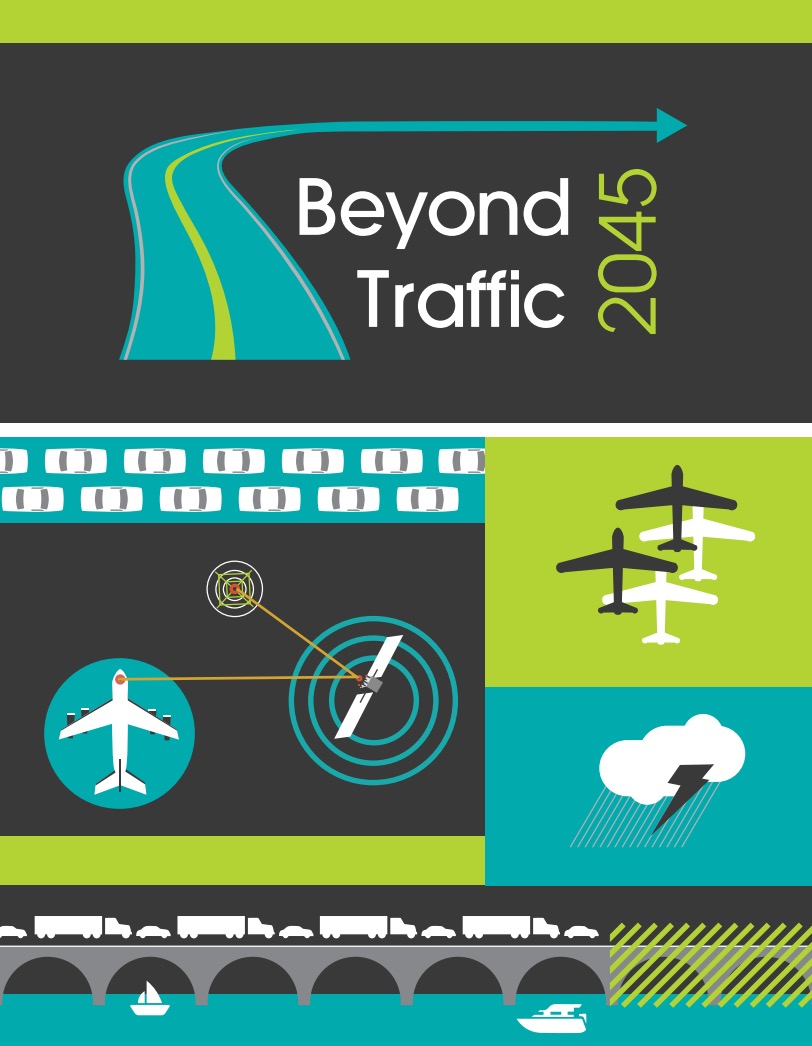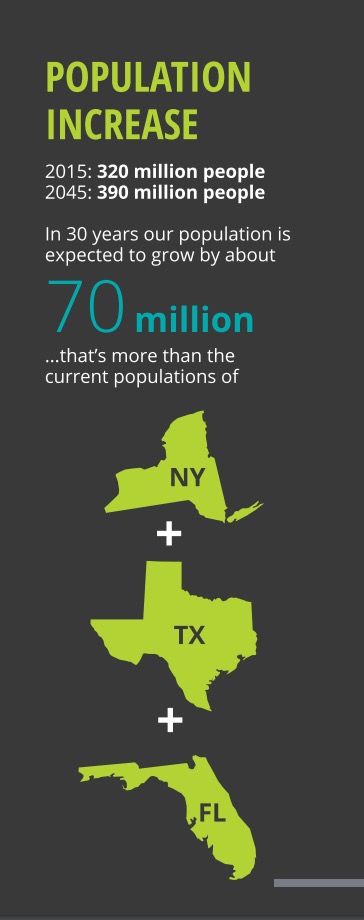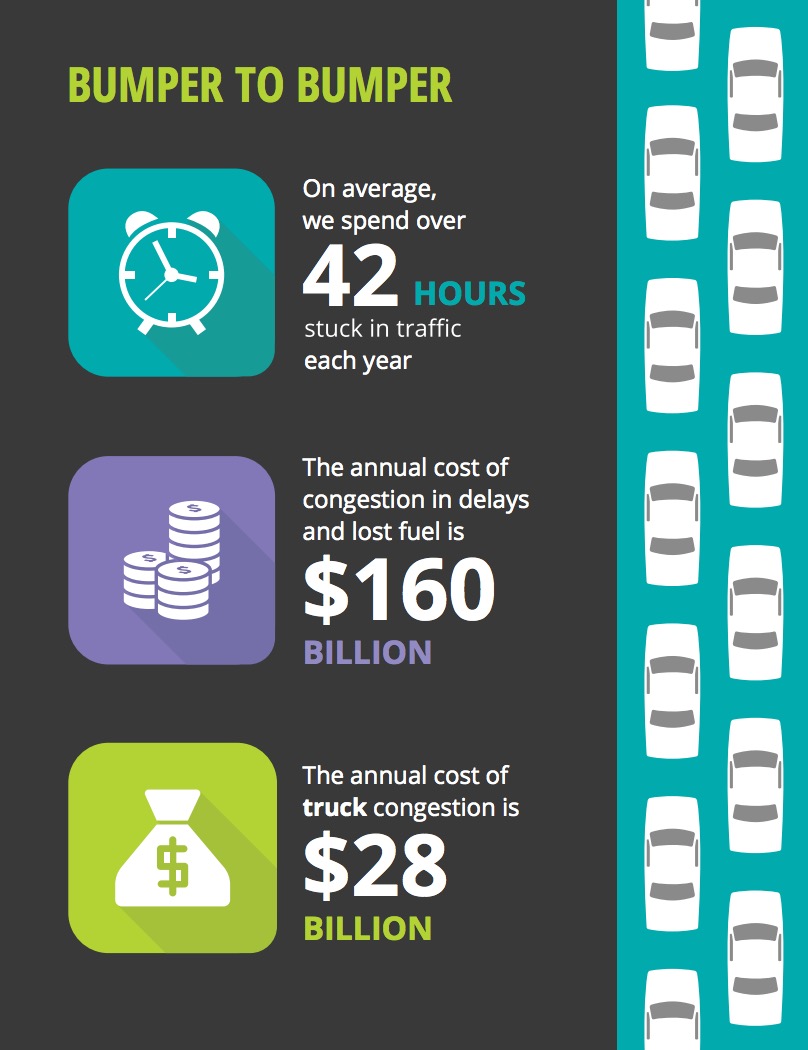UNITED STATES DEPARTMENT OF TRANSPORTATION (US DOT)
Introduction: Summary in Brief
 When the United States Department of Transportation was created, the Secretary of Transportation was charged by law to report on both the current and the anticipated future conditions of our nation’s transportation system. Beyond Traffic 2045 is U.S. DOT’s most comprehensive assessment of current and future conditions in decades—it is a call to action. After years of chronic underinvestment and policy choices that, in some cases, have actually worked at cross purposes with the broader economic and social goals held by most Americans, now is the time for a report like this one to be read, understood, considered—and used, to breathe new life into funding and policy discussions at all levels.
When the United States Department of Transportation was created, the Secretary of Transportation was charged by law to report on both the current and the anticipated future conditions of our nation’s transportation system. Beyond Traffic 2045 is U.S. DOT’s most comprehensive assessment of current and future conditions in decades—it is a call to action. After years of chronic underinvestment and policy choices that, in some cases, have actually worked at cross purposes with the broader economic and social goals held by most Americans, now is the time for a report like this one to be read, understood, considered—and used, to breathe new life into funding and policy discussions at all levels.
Importantly, Beyond Traffic doesn’t prescribe a course of action. It doesn’t advocate for specific or partisan solutions. And because we know that we can’t predict the future with complete accuracy, Beyond Traffic doesn’t contain the blueprints for solving all of the transportation challenges our nation faces. Instead, Beyond Traffic presents and analyzes the long-term and emerging trends that will shape our transportation system. By doing this, it provides a framework for the factual, rooted-in-reality discussions we will need to have about coming to grips with what our needs really are, and what our priorities will have to be.
Now is an exciting time to have this discussion. Our transportation system is on the cusp of a major transformation, akin to the introduction of the steam engine or the automobile. New technologies and business models—automated vehicles, electric cars, unmanned aerial systems, NextGen air-traffic operations, and mobility on demand, to name just a few—promise to dramatically improve the safety, efficiency, competitiveness, accessibility, and sustainability of our transportation system. To realize this transformation, we will need a corresponding transformation in our transportation policy.
- To promote the adoption of new technologies, we must create a governance system that enables and incentivizes innovation rather than stifles it: reducing regulatory barriers, promoting technology transfer and capacity building, and spurring basic research across all modes of transportation—even as safety remains our top priority.
- To encourage economic development, we will need to articulate policies that promote employment, economic growth, access and opportunity for all Americans, and our competitiveness on a global scale.
- To ensure a return on our transportation investments, we will need to evaluate them against what our needs truly are, and to choose projects that will deliver the most benefits, and the best value for money
- To obtain the funding we will need, we must identify the best opportunities for public investment, public-private partnerships, and other financing mechanisms.
For the U.S. Department of Transportation, that transformation has already begun. In just the past year, we have made great strides in how we make investments and regulate technologies:
- We released the Federal Automated Vehicle Policy Statement, which lays the groundwork for the safe development, testing, and regulation of highly automated vehicles.
- We launched the Smart City Challenge, which inspired 78 cities to develop visions to transform urban mobility, and we committed $40 million to help Columbus, Ohio, become the country’s first city to fully integrate innovative technologies into their transportation network.
- We developed the Small Unmanned Aerial Systems Rule, providing national guidelines for the operation of non-recreational unmanned aircraft under 55 pounds, to enable the commercial application of drones by a wide range of industries.
- We launched a series of initiatives, like the Every Place Counts Challenge, to demonstrate how innovative transportation projects, learn from our long history, can revitalize communities and connect people to opportunity.
In short, our challenge is to build a transportation system that meets the needs of the future—not the past. We may not be able to predict the future with certainty—but we are certain that if we fail to adapt, we will fall behind.
Our nation once had a transportation system that was the envy of the world. We built the Erie Canal, the Transcontinental Railroad, the Interstate Highway System, and set the world standard for aviation. These investments, each in their turn, opened up enormous opportunities for Americans: creating jobs and new sources of wealth, opening markets, and giving American businesses a significant advantage over economic competitors.
But Beyond Traffic reveals that over the next thirty years, our transportation system, which has powered our rise as a nation and enabled generations of economic growth, could become a drag on our economy and our way of life. Some warning signs are already all too clear. This year, for instance, the average American driver in a city or a suburb will spend an entire work week sitting in traffic. This year, trucks will lose $28 billion in wasted time and fuel. This year, the companies that depend on our nation’s transportation system—and the millions of workers who power those companies—will feel the effects.
And the effects are stark. Many of our major hub airports face severe congestion, which causes delays that have become chronic. Aging locks and dams are raising the costs of moving freight and fuel along our inland waterways. Ports need dredging and modernization if they are going to continue to compete, and to sustain jobs and regional economies. The transit systems that support millions of commuters throughout America face a $100 billion maintenance backlog and are becoming increasingly unreliable.
Most troubling of all, and bucking a long historical trend of steady improvements, is an increase in traffic fatalities, which rose a startling 7 percent in 2015. Preliminary estimates for the first half of 2016 are even more alarming—an increase of over 10 percent compared to the first half of 2015. Last year, 35,092 people were killed in traffic crashes. These people are all of us: your neighbor driving to work. Your niece walking to the park. Your brother biking home. Each day in America, nearly 100 people die from vehicle-related accidents. We should not accept even one.
These are problems we must fix. The good news is: these are problems we can fix. The future is a choice that is ours to make. But, of course, to shape the future we desire—a future where no one dies on our highways, flights and freight are not chronically delayed, and our efficient, clean, and accessible transportation system is again the envy of the world—we must start now. To truly move Beyond Traffic, we must begin making choices today.
Our analysis characterizes six major trends shaping transportation, and objectively identifies the critical policy choices we will need to make.
 First, how will we move? How will we build a transportation system to accommodate a growing population and changing travel patterns?
First, how will we move? How will we build a transportation system to accommodate a growing population and changing travel patterns?
- America’s population will grow by 70 million by 2045.
- By 2050, emerging megaregions could absorb 75 percent of the U.S. population; rural populations are expected to continue declining.
- Population growth will be greatest in the South and West; existing infrastructure might not be able to accommodate it.
- It is possible that Americans, particularly millennials, will continue—as a matter of preference—reducing trips by car in favor of more trips by transit and intercity passenger rail.
- By 2045, there will be nearly twice as many older Americans as now; they will need quality connections to medical care and related services.
Our basic policy for decades has been to expand capacity to meet demand by building new facilities. This in itself may not be enough in the face of a growing and changing population, increasing congestion, and deteriorating infrastructure conditions.
Key policy options to address how we will move include:
- Increase infrastructure capacity: build new roads, bridges, and other facilities; maintain existing facilities more effectively; use existing facilities more effectively by implementing better designs and technologies; or use some combination of these methods
- Reduce congestion through land use, telework and flex-time work schedules, smaller and automated vehicles, and pricing
- Promote public transit, biking, walking, and mobility on demand
Second, how will we move things? And reduce freight chokepoints that drive up the cost of doing business?
- By 2045, freight volume will increase by more than 40 percent.
- Online shopping is driving up demand for small package home delivery, which could soon substitute for many household shopping trips.
- Airline mergers and the consolidation of hubs may result in increased air traffic congestion.
- International trade balances, due in part to low U.S. energy costs, could shift from imports toward exports, but overall globalization will increase both, straining ports and border crossings.
- Strong domestic energy production may enable the U.S. to become a natural gas net exporter by 2020, but pipeline capacity may hamper growth and lead to greater movement of oil by rail.
Key policy options to address how we will move things include:
- Improve freight planning and coordination at national, regional and local levels
- Target policies and investments aimed at resolving freight congestion
- Encourage innovative strategies to address first- and last-mile freight issues
Third, how will we adapt? And make our infrastructure more resilient?
- Predicted rises in global temperatures and mean sea levels, and more frequent and intense storm events, could drastically affect highways, bridges, public transportation, coastal ports, and waterways.
- Federal fuel economy standards are slated to rise to the equivalent of 54.5 miles per gallon by 2025.
- Sales of hybrid and plug-in electric vehicles are growing rapidly and have the potential to greatly reduce transportation emissions.
Key policy options to address how we will adapt include:
- Reduce transportation emissions by improving fuel efficiency and increasing the use of alternative, cleaner fuels
- Align costs and incentives to encourage sustainable development patterns and research into new technologies that can aid in reducing greenhouse-gas emissions and energy use
- Design and build better infrastructure that is more resilient to events such as severe storms, rising sea levels, and flooding
- Avoid developments in vulnerable locations
Fourth, how will we move better? And knock down barriers to new technologies that promise to make travel safer, cheaper, and more convenient?
- Technological changes and innovation may transform vehicles, infrastructure, logistics, and the delivery of transportation services.
- New sources of travel data have the potential to improve travelers’ experiences, support more efficient management of transportation systems, and inform thoughtful investment decisions.
- Automation and robotics will affect all modes of transportation, improving infrastructure maintenance and travel safety, and enabling the mainstream use of autonomous vehicles.
Key policy options to address how we will move better include:
- Address regulatory barriers to deployment of new technologies or procedures; develop infrastructure and standards to support emerging technologies
- Collect and manage data and transition to a data-driven investment system, while protecting individual privacy
- Support research on technological developments and deployment
- Maintain a paramount focus on safety
Fifth, how will we grow opportunity for all? How will we create a transportation system that connects all Americans to the American dream?
- The top 10 percent of income-earning families now earn as much income as the remaining 90 percent.
- Middle- and low-income American households spend, on average, nearly 20 percent of their income on transportation and 40 percent on housing—higher shares than for wealthier Americans.
- Between 2000 and 2012, the number of poor people living in suburbs increased from 10 million to 16.5 million. Today, more poor people live in the suburbs than in the cities or rural areas.
- Sprawling urban development is increasing, as is economic segregation; economic opportunity and social mobility are decreasing.
Key policy options to address how we will grow opportunity for all include:
- Prioritize transportation investments in communities with the greatest needs, and ensure that local communities benefit from transportation investments
- Coordinate transportation and land-use policy, so that different kinds of decisions reinforce each other for community good
- Support affordable transportation services accessible to all Americans
 Finally, how will we align decisions and dollars? And invest the trillions of dollars our transportation system needs in the smartest way possible?
Finally, how will we align decisions and dollars? And invest the trillions of dollars our transportation system needs in the smartest way possible?
- Public revenues to support transportation are not keeping up with the rising costs of maintenance and capacity expansion.
- Nearly two-thirds of our roads are rated in less than good condition; a quarter of our bridges need significant repair.
- Federal gasoline-tax revenues have failed to keep up with our transportation needs and could decline further as vehicle fuel efficiency improves, and inflation further erodes purchasing power.
- Insufficient highway and transit revenues and the absence of reliable federal funding for rail, marine highways, and ports have created a need for new financing mechanisms
Key policy options to address how we will align decisions and dollars include:
- Ensure adequate revenues to address critical needs, through existing taxes, new excise taxes, user fees, tolls, congestion pricing, vehicle-miles-traveled fees, or other funding mechanisms
- Reduce spending to match revenues, and address the resulting consequences to the transportation system
- Prioritize investments based on performance outcomes
- Ensure clear roles of the public and private sectors: clarify authorities; seek changes in authority (e.g., greater federal role, the devolution of more functions to non-federal entities, privatization); improve investment coordination between sectors and levels of government
Beyond Traffic does not close the book on these questions. It opens the book wider, giving all of us more and better data with which to answer them.
Our hope is that Beyond Traffic provides Americans with a common basis of fact for a larger national discussion about the future of transportation. The trends shaping our transportation system will require changes in policy, new approaches to planning, and greater coordination between all levels of government, and between government and the private sector. These are, individually big challenges; in its totality, the task is daunting.
We can do it.
Let’s get started on our transportation future.
Download full version (PDF): Beyond Traffic 2045
About the United States Department of Transportation
www.transportation.gov
The mission of the Department is to: Serve the United States by ensuring a fast, safe, efficient, accessible and convenient transportation system that meets our vital national interests and enhances the quality of life of the American people, today and into the future.
Tags: Anthony Foxx, Beyond Traffic, Secretary Foxx, Traffic, United States Department of Transportation, US DOT






 RSS Feed
RSS Feed